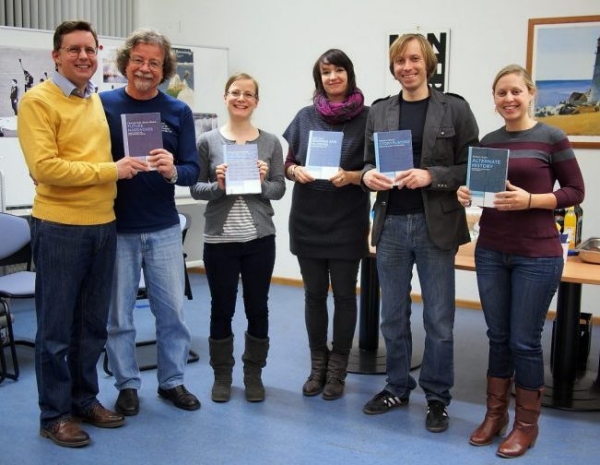Narrating Futures
The "Narrating Futures (NAFU)" project was funded through an Advanced Investigator Grant of the European Research Council. The funding period was April 1, 2009 through March 31, 2012. In addition to its Principal Investigator, Prof. Dr. Christoph Bode, the research team consisted of PD Dr. Sebastian Domsch, Jeffrey Kranhold, Dr. Felicitas Menhard (now: Meifert-Menhard), Dr. Kathleen 'Katie' Singles, and Dr. Sabine Schenk.
The fundamental idea of "Narrating Futures" is a very simple one: as a rule, narratives have events as their minimal units. But there is a certain, hitherto undiscovered corpus of narratives that have, in addition to events, one special feature, indeed differentia specifica, that other narratives don't have: they have nodes. A node is a situation that allows for more than one continuation. The simplest kind of node is a bifurcation, but most nodes have more than just two continuations. If a narrative has at least one node, then we call it a 'Future Narrative', in contradistinction to narratives that have 'only' events – they are 'Past Narratives'. So the definition of a FN is a purely technical one: if a narrative has a least one node, it's in – if not, it's out.
One of the resulting differences between FNs and PNs is that, whereas PNs are uni-linear, FNs are, by definition, multi-linear. One of the exciting aspects of FNs is that the concept cuts across all media boundaries: you find FNs in printed books, in movies, in games, or in computer simulations. Another exciting aspect is that it bridges the fiction-/non-fiction divide; or, if I may switch my metaphors: FNs can be found on both sides of the fence.
From a narratological point of view, the problem with FNs is that practically all the narratology we have is derived from the corpus of Past Narratives. The NAFU research project promised to address this situation and – given enough money and three years' time – to come up with a general and abstract theory and poetics of FNs. This is what this first volume of the Narrating Futures series purports to offer.
At the same time, while we were confident and unwavering in our optimism that such a general theory of FNs could be sketched, we also saw the need to delineate concretely how FNs are refracted through the different media. So our drive was directed both towards abstraction and towards the concrete, for we could not help but notice that FNs, while still one corpus, are also media-sensitive to a considerable degree.
That is why volume 1 is followed and complemented by volumes 2 through 5, which show, respectively, how FNs 'work' in print and digiture, in film and new visual media, in computer and online games, and, in volume 5, how the subgenre of alternate histories (novels of the 'what if?' kind) is theoretically and practically related to FNs (some alternate history novels are FNs, and some FNs are alternate histories – but the full story is a bit more complex).
As we were working through masses of material, we realized that the media-theoretical order of this series also reflects a media-historical dimension. There is something in the sequence of 'printed book – movie – interactive visual medium – complex electronic game' that suggests, if not an evolution or teleology, at least a discernible trend towards the possibility of ever greater orchestration of FNs and of an increase of what we have come to call 'nodal power', that is, the degree of openness that any nodal situation offers. We felt that this had to be addressed especially in a media-historical sketch towards the end of volume 1, because it would have been systematically displaced in any of the following four volumes.
That is why volume 1 appears as it does: part one, written by the Principal Investigator, Christoph Bode, offers a first blueprint of a theory and a poetics of FNs. True to the claim that if, in spite of all differences in appearance, the corpus of FNs is defined by one exclusive feature, viz. that a FN has at least one node, it should be possible to offer a formal, most abstract description of how a FN 'works' in general, of what the architecture of FNs looks like. This is what is attempted in part two of volume 1, which was written by Rainer Dietrich. The relation of these two parts can be characterized as follows: whereas part one is a narrative, part two is an abstraction based on mathematical Graph Theory. Part three, again written by Christoph Bode, is the media-historical sketch just mentioned. It offers a tentative explanation of the curious fact that, although all the necessary ingredients for the full-scale emergence of FNs seem to have appeared between 1660 and 1720, it still took the corpus of FNs another 250 years or so to materialize and take off and then, all of a sudden, bloom and mushroom into the dominating corpus it now is. For it is easy to see that it is not only the future that belongs to FNs – it's already here: the present is the period of FNs, for we are increasingly thinking in terms of possibility, contingency, openness, multiple paths, tipping points and feedbacks, and this simply cannot be communicated in a uni-linear form.
ERC-Funded Research in Germany

The NAFU writers at the book launch party in fall 2013, celebrating the joint publication of five volumes of research results.
Christoph Bode (Ed.), NARRATING FUTURES:
Christoph Bode, Rainer Dietrich: VOLUME 1: FUTURE NARRATIVES: Theory, Poetics, and Media-Historical Moment
Felicitas Meifert-Menhard: VOLUME 2: PLAYING THE TEXT, PERFORMING THE FUTURE: Future Narratives in Print and Digiture
Sabine Schenk: VOLUME 3: RUNNING AND CLICKING: Future Narratives in Film
Sebastian Domsch: VOLUME 4: STORYPLAYING: Agency and Narrative in Video Games
Kathleen Singles: VOLUME 5: ALTERNATE HISTORY: Playing with Contingency and Necessity
Reviews:
Mark Bruhn, "Narrating Futures, vol. 1: Future Narratives"
Stefan Schubert: "Mit Geschichten spielen: Sebastian Domschs Storyplaying als Ansatz zur Analyse von Narrativität in Videospielen"

